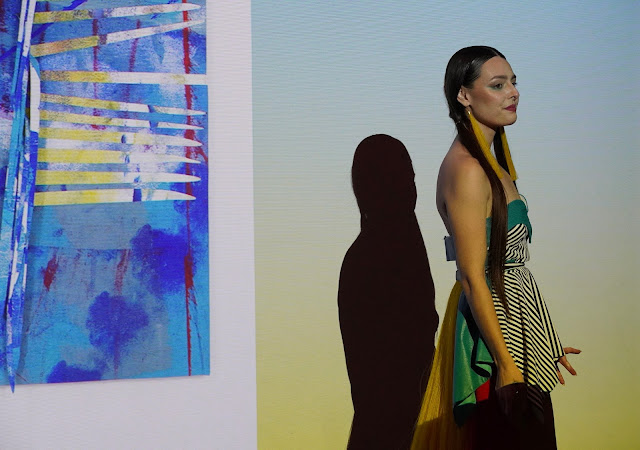Dina Craissati has submitted a photo series from a Native fashion show, entitled kisewâtisiw miyootootow - S/he is Mercifully Respectful, that took place at the McCord Museum, Montreal, on 17 February 2024. The show, Dina writes, featured the work of the multidisciplinary Métis artist, fashion designer and educator Jason Baerg. It was a wonderful opportunity to discover and learn about Indigenous creativity. Here what she had to say to accompany the photos.
Jason Baerg was raised in Prince Albert, the third-largest city of Saskatchewan (one of Canada’s Western provinces) that has been inhabited for thousands of years by Indigenous groups (First Nations, Inuit, and Métis). He started sketching fashion designs as a teenager and focused on Indigenous representation in art as a way to reclaim his peoples’ stories, elevate Indigenous voices, and celebrate Indigenous cultures. He played a key role in the Indigenous renaissance by championing Métis art and artists through active community development, contributing substantially to such national arts organizations as The National Indigenous Media Arts Coalition, the Independent Media Arts Alliance, the Aboriginal Curatorial Collective (and many more), challenging thereby theinequities in the underrepresentation of Métis artists in national exhibitions, art histories and institutional collections.
Baerg’s pieces (and show) blur the distinction between art and fashion. Each attire is meant to be an artistic endeavour. His objective is to encode in each a vision that combines heritage with futuristic forms and concepts. The collection blends elements of ceremony from his cultural lineage (molten core of the earth, four directions of the globe, cosmology, language) together with electric colours and bold patterns. Handmade botanical prints and natural dyes, inspired by the Indigenous plants of Saskatchewan, activate the garment's surface, while metallic accents cut an edge of severity.
The particularity of the show is that it was not just about clothes, but rather about a dynamic artistic space of laser cut shaped canvases and colored media installations where the models were moving. This was meant to speak to Indigenous notions of the passage of time, the relationship between the earth, water and sun and the radical need for respect, love, and care.
The photographs are based on the rule of thirds in photography to convey the dynamism and movement in the show. Furthermore, color and shadow contrasts were used to emphasize the depth and emotion of the ambience during the event.










Brilliant! What a feast for the eyes. Merrrrci pour le partage.
ReplyDeleteThanks Maie!
DeleteWonderful Dina! Here’s an Australian one!
ReplyDeletehttps://amp.abc.net.au/article/102711846
Hi Elaine - nice share.
Delete